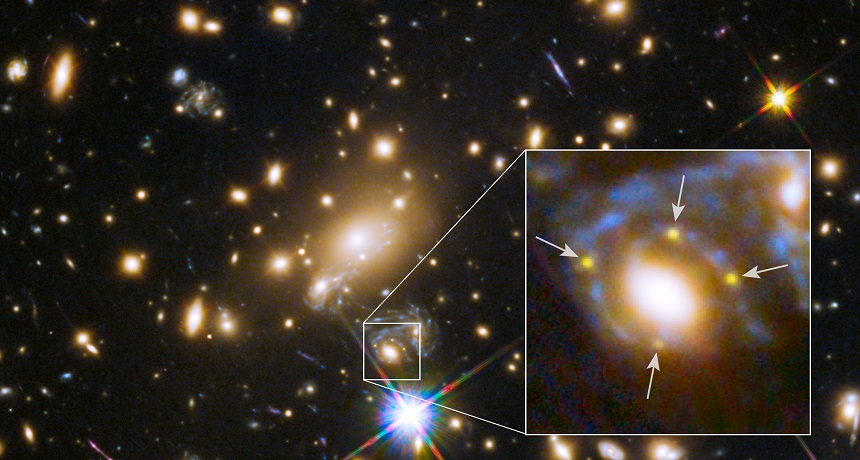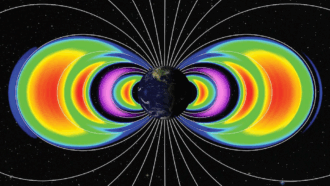Galaxy cluster creates ‘magnifying glass’ in space
Scientists watch a distant supernova through a gravity lens

In this view from the Hubble Space Telescope, a massive galaxy in a cluster of galaxies produces multiple images of a single distant supernova behind it. The images of the exploding star are arranged in a cross-shaped pattern called an Einstein cross. In the enlarged inset view, arrows point to the four images.
Z. Levay at NASA’s Space Telescope Science Institute and ESA
Share this:
- Share via email (Opens in new window) Email
- Click to share on Facebook (Opens in new window) Facebook
- Click to share on X (Opens in new window) X
- Click to share on Pinterest (Opens in new window) Pinterest
- Click to share on Reddit (Opens in new window) Reddit
- Share to Google Classroom (Opens in new window) Google Classroom
- Click to print (Opens in new window) Print
By Ilima Loomis
With some massive help from gravity, astronomers are getting a chance to study a star that exploded on the far side of the universe.
That exploding star is known as Supernova Refsdal. It’s 9.3 billion light-years from Earth. That’s so far that even with the strongest of telescopes, it can’t be seen from Earth. But there is a massive galaxy within a cluster of galaxies located between the supernova and Earth. The galaxy’s gravity has bent the distant supernova’s light. Astronomers refer to such light bending as a gravitational lens. It works like a magnifying glass in space. And that lens has made the supernova visible.
“It’s interesting to be able to study such a distant supernova,” says Patrick Kelly. He’s an astronomer at the University of California, Berkeley. “We would have no way of seeing it if it wasn’t behind the lens,” he explains. His team reported the new lens March 6 in the journal Science.
Kelly found the supernova while studying images taken November 10, 2014 by the Hubble Space Telescope.
Scientists have been studying gravitational lenses for about 30 years. There are hundreds of thousands of small lenses in space, notes Harald Ebeling. He’s an astronomer with the University of Hawaii Institute for Astronomy in Honolulu. He’s also an expert on gravitational lenses.
Only about 25 of these natural lenses are strong enough to magnify objects across the universe, he says. And this is the first to magnify a supernova. The newfound supernova gives scientists a way to study the strange ways intense gravitational sources bend light.
Gravitational lenses sometimes create an odd feature: four images of the object that they are magnifying. The scientific term for this is an Einstein cross. The pattern occurs because the light splits as it moves through the lens. Since the light takes different paths through the lens, each of the four images arrives at Earth after different lengths of time.
Most objects seen through lenses appear the same in each image. Stars, for instance, emit a steady beam of light and don’t change much. But an exploding supernova appears for only a short time and then disappears. That explosion will appear at a different time in each of those four parts of the Einstein cross. Scientists can measure the time delay between the appearance of the supernova in each of the images to get clues about gravity and the mass of the galaxy (or galaxy cluster) creating the lens.
“It’s very rare to get something like this,” Ebeling says. “The timing was just perfect.”
Kelly thinks the first two images of the supernova actually arrived in 1964 and 1995, but “we missed it.” Thanks to the time delay, the image will appear one more time, giving astronomers a replay of the supernova. But Kelly can’t say when.
“Nothing like this has ever happened before,” he says. “So it’s hard to know exactly what will happen.”
Power Words
(for more about Power Words, click here)
astronomy The area of science that deals with celestial objects, space and the physical universe as a whole. People who work in this field are called astronomers.
Einstein cross Albert Einstein’s General Theory of Relativity, in 1915, proposed that gravity can bend light. This bending can create an optical illusion — the image of the same distant light source, repeated four times in a “cross-like” pattern. It takes a very massive object or community of objects to do this.
galaxy A massive group of stars bound together by gravity. Galaxies, which each typically include between 10 million and 100 trillion stars, also include clouds of gas, dust and the remnants of exploded stars.
galaxy cluster A group of galaxies held together by gravity. Galaxy clusters are the largest known objects in the universe.
gravitational lensing The distortion of space and time by an intense gravitational force, such as what can be exerted by clusters of galaxies — the most massive things in the universe.
gravity The force that attracts anything with mass, or bulk, toward any other thing with mass. The more mass that something has, the greater its gravity.
lens (in physics) A transparent material that can either focus or spread out parallel rays of light as they pass through it.
light-year The distance light travels in one year, about 9.48 trillion kilometers (almost 6 trillion miles). To get some idea of this length, imagine a rope long enough to wrap around the Earth. It would be a little over 40,000 kilometers (24,900 miles) long. Lay it out straight. Now lay another 236 million more that are the same length, end-to-end, right after the first. The total distance they now span would equal one light-year.
mass A number that shows how much an object resists speeding up and slowing down — basically a measure of how much matter that object is made from.
star Thebasic building block from which galaxies are made. Stars develop when gravity compacts clouds of gas. When they become dense enough to sustain nuclear-fusion reactions, stars will emit light and sometimes other forms of electromagnetic radiation. The sun is our closest star.
supernova (plural: supernovae or supernovas) A massive star that suddenly increases greatly in brightness because of a catastrophic explosion that ejects most of its mass.
telescope Usually a light-collecting instrument that makes distant objects appear nearer through the use of lenses or a combination of curved mirrors and lenses. Some, however, collect radio emissions (energy from a different portion of the electromagnetic spectrum) through a network of antennas.






